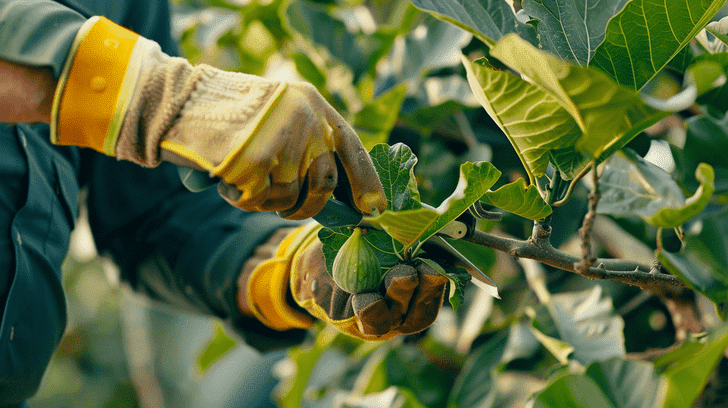How Often Should You Trim Trees?
Regularly trim young trees every 1-5 years to promote healthy growth. Mature trees benefit from annual inspections or 5-10-year cycles, tailored to their growth rate. Fruit trees thrive with annual trimming for best fruit production.
Establish a routine for evergreen trees, checking yearly for dead branches. Factors like tree age, species, health, and location determine trimming frequency.
Geographical area affects how often you should trim; seek expert advice. Discover the best month for trimming to promote tree health.
Neglecting pruning can lead to weakened trees and lower fruit yields. Proper trimming practices are essential for tree health and aesthetics.
How Often to Trim Trees
To maintain peak tree health, you should inspect and trim young trees every 1-5 years and mature trees annually or on a 5-10 year cycle.
Fruit trees may require yearly trimming for enhanced fruit production.
Evergreen trees should be pruned if there are dead or diseased branches, with regular inspections being essential for their well-being.
Young Trees
For young trees, it’s essential to take into account the unique characteristics of each tree when determining the best approach to maintaining their health and growth.
Inspecting and trimming them every 1-5 years is vital for promoting their development properly. The frequency of trimming may vary based on factors such as tree age, species, and location.
Younger trees, especially those in their early growth stages, benefit from more frequent inspections and trimmings to shape their growth.
Different tree species may have specific requirements regarding trimming schedules, so it’s important to carefully assess each tree.
Mature Trees
Inspect mature trees yearly to determine the best timing for their trimming, aiming for a 5-10 year cycle for maintaining their health and structural integrity. Consulting with an arborist can help identify the specific needs of your trees based on their growth rate.
Fast-growing trees may require more frequent trimming to manage their growth and maintain shape, while slow-growing trees can often go longer between trims.
Understanding the seasonal requirements of your trees is essential. Trimming during the dormant season, typically fall to winter, is generally most beneficial for mature trees. This timing promotes healthy growth and minimizes stress on the tree.
Fruit Trees
When maintaining fruit trees, it is crucial to establish a regular trimming schedule to encourage healthy growth and enhance fruit production.
Annual trimming of fruit trees not only maintains their shape but also increases fruit size and quality.
Hiring a professional arborist guarantees that the trimming is done correctly, promoting excellent growth. Below is a table summarizing the benefits of annual trimming for fruit trees:
| Benefit | Description |
| Increases Fruit Size | Regular trimming leads to larger fruits |
| Enhances Fruit Quality | Trimming promotes better-tasting fruits |
| Promotes New Growth | Encourages the growth of new branches |
| Ensures Tree Health | Trimming helps maintain tree vitality |
| Professional Guidance | Arborists offer expert advice on care |
Evergreen Trees
Establishing a regular trimming schedule for your evergreen trees is key to promoting their health and natural state. Inspect your evergreens annually, especially during dormancy in fall or winter. Trim if you notice dead branches, as these can affect overall tree health.
Pruning is also essential if the canopy becomes overgrown, as it may hinder sunlight exposure and air circulation. However, be cautious not to over-prune, as evergreens often shed weak branches naturally. Letting them self-manage to some extent maintains their resilience.
Best Time of Year to Trim Trees
For peak tree health, consulting with a professional is crucial to determine the best time to trim trees. This is typically during the dormant season, often in late winter or early spring. During this period, trees aren’t actively growing, allowing them to heal faster and conserve energy for new growth in the upcoming season.
Trimming in fall or winter helps prevent stress on the tree, as it has stored energy reserves without the need to support new growth. Seeking expert advice ensures proper timing for specific tree species and health conditions.
Factors affecting trimming frequency
When determining how often to trim your trees, several critical factors come into play. The age of the tree, its specific species, overall health, and where it’s located all influence the frequency of necessary trimming.
Understanding these key points will help you develop a tailored tree care plan for best growth and longevity.
Tree age
To determine the best trimming frequency based on tree age, assess the growth stage and health of the tree.
Young trees, especially those with diseased branches, damaged branches, misshapen canopy, or suckers, benefit from more frequent trimming to promote healthy growth.
Typically, young trees should be inspected and trimmed every 1-5 years to shape their structure and remove any potential hazards.
On the other hand, mature trees may require less frequent trimming, around every 5-10 years, as they’re more established and less prone to rapid changes.
Monitoring the development of your trees closely and addressing any issues promptly will help maintain their strength and longevity.
Tree species
Evaluating the tree species is vital in determining the best frequency for trimming, tailored to the specific growth patterns and characteristics of each type of tree.
Some species, like fast-growing water sprouts, may require more frequent trimming to maintain shape and prevent overcrowding near power lines or buildings.
Trees that tend to have branches reaching towards power lines should be regularly inspected and trimmed to avoid potential hazards.
On the other hand, certain tree species may naturally shed weak or dead branches, reducing the need for frequent trimming.
Understanding the unique traits of each tree type is essential in establishing an appropriate trimming schedule that guarantees both tree health and safety around structures and power lines.
Tree health
Understanding the factors that influence tree health is essential in determining the best frequency for tree trimming. Factors such as tree species, age, location, and environmental conditions play a vital role in the overall health of your trees.
Young trees generally require more frequent trimming to establish proper structure and growth, while mature trees benefit from periodic maintenance to remove dead or diseased branches.
Fruit trees, on the other hand, may need annual pruning to promote fruit production and overall health.
Location
Factors such as the geographical location of your trees have a significant impact on the frequency at which tree trimming should be conducted. Trees in regions with fast-growing seasons may require more frequent trimming to manage growth.
Coastal areas with high winds might need trimming to prevent damage during storms. In urban settings, trees near buildings or power lines could demand regular pruning for safety. In colder climates, trimming before winter can help trees withstand harsh conditions.
Understanding your tree’s location-specific needs is vital for maintaining its health and appearance. Consult with a certified arborist familiar with your area to determine the best trimming schedule for your trees.
Risks of Improper Tree Trimming
Improper tree trimming poses significant risks to the health and stability of your trees. When trees are pruned incorrectly, it can lead to various issues.
Over-pruning weakens trees by reducing their ability to produce food and inviting pests and diseases. This can result in a tree becoming more vulnerable to wind damage and further health complications. Poor cuts during trimming may also introduce pests and diseases to the tree.
To maintain top tree health and prevent these risks, it’s essential to adhere to proper pruning practices. Always consult with a certified arborist for guidance on the correct techniques and frequencies for trimming your trees to ensure their longevity and well-being.
FAQ
How do you know when a tree needs to be trimmed?
Determining when a tree needs trimming involves evaluating its overall health, growth patterns, and any signs of dead or damaged branches. Start by checking for any dead or diseased limbs, which can hinder the tree’s growth and pose safety hazards.
Look for branches that are crossing or rubbing against each other, as they can cause damage and disease. Assess the tree’s shape and size; if it’s becoming too dense or top-heavy, it might need trimming to maintain balance.
Keep an eye out for any signs of decay, such as fungi growing on the trunk or branches. Regular inspections and proactive trimming can help keep your trees healthy and thriving.
What month is best to trim trees?
For optimal tree health and growth, the best month to trim trees is typically during the dormant season in late winter or early spring. Trimming during this period, after the tree has shed its leaves but before new growth begins, promotes healthy growth and reduces stress on the tree.
Late winter to early spring is ideal as it allows the tree to focus its energy on healing and new growth once the trimming is complete. Avoid trimming during active growth periods to prevent potential harm to the tree.
Seeking advice from a professional arborist on the specific timing for your tree species can guarantee the best results and long-term tree health.
What happens if you don’t prune a tree?
Neglecting to prune a tree can lead to a variety of detrimental effects on its health and overall well-being.
Without proper pruning, trees can suffer from decreased sunlight exposure, increased vulnerability to diseases and pests, structural issues, and reduced fruit production. Here is a breakdown of the consequences of not pruning a tree:
| Effects of Not Pruning a Tree | Consequences |
| Reduced Sunlight Exposure | Weakens tree health |
| Increased Pest Vulnerability | Higher risk of infestations |
| Structural Instability | Susceptibility to storm damage |
| Decreased Fruit Production | Lower yields and quality |
Regular pruning is essential to maintain the health and aesthetics of trees. Be mindful of the impact of neglecting this vital aspect of tree care.
Conclusion
To sum up, trimming your trees regularly is like giving them a haircut to keep them healthy and thriving. Just like how we need regular maintenance to stay in top shape, trees benefit from consistent care.
By scheduling regular inspections and trimmings, you can guarantee your trees stay strong and beautiful for years to come. So, grab those pruning shears and show your trees some love!







